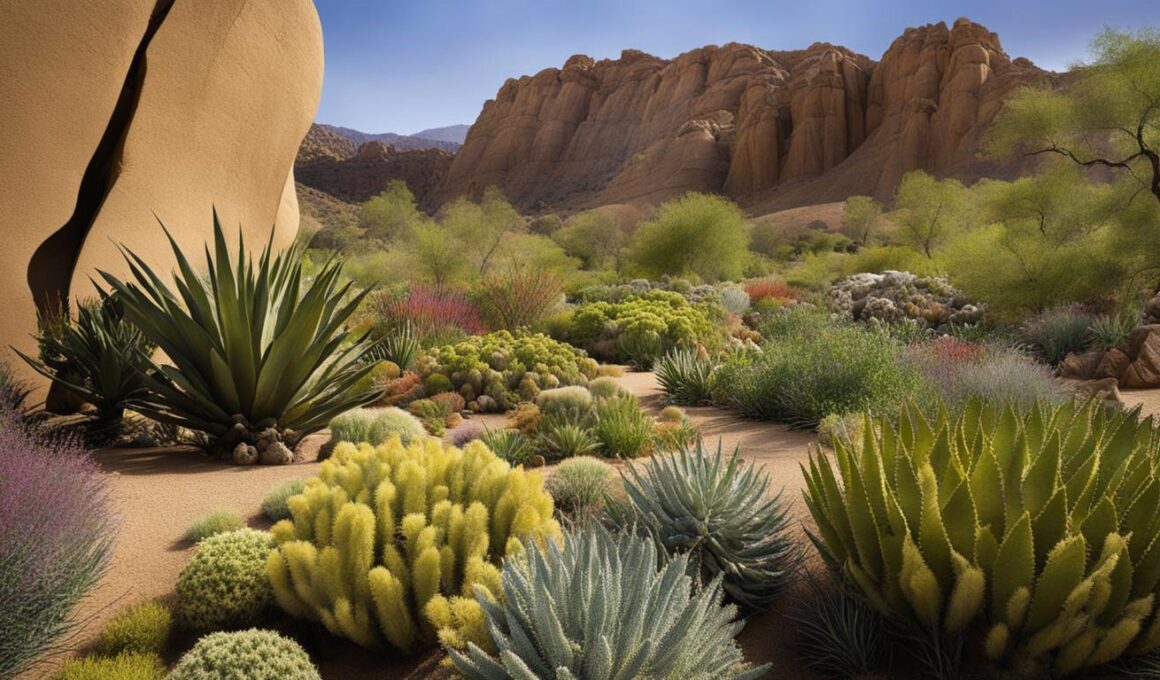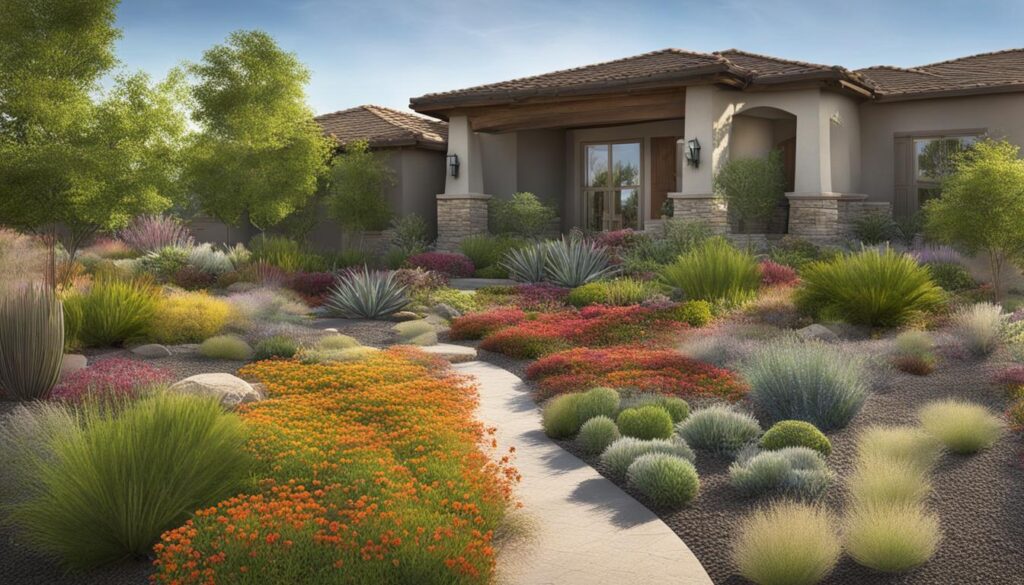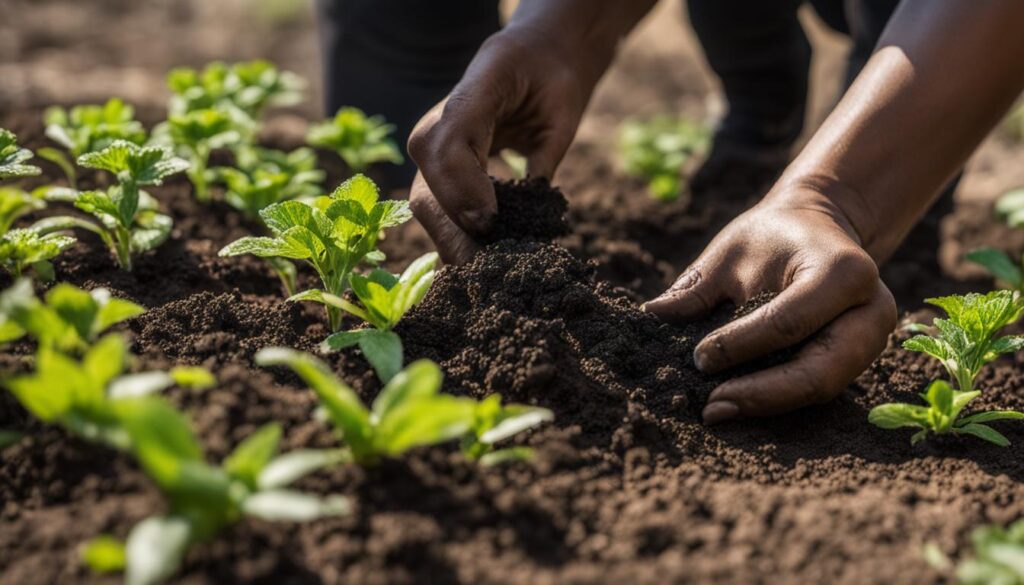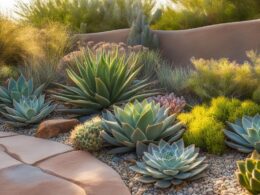Are you looking for ways to save water and create a beautiful, drought-resistant landscape? Look no further than xeriscaping principles. Xeriscaping is a landscaping technique that focuses on conserving water while still achieving stunning results. By implementing these principles, you can create a sustainable garden that thrives in even the driest conditions.
Key Takeaways:
- Xeriscaping is a landscaping technique that aims to conserve water while creating a lush and beautiful landscape.
- By considering the regional climate and soil conditions, you can design a water-efficient landscape that thrives in your specific environment.
- Proper soil preparation is essential for moisture retention, healthy root systems, and the growth of drought-tolerant plants.
- Selecting and grouping plants based on their water needs is crucial for a water-efficient landscape.
- Xeriscaping not only benefits the environment but also reduces water bills and lowers maintenance requirements.
Plan and Design Your Landscape to Match the Regional Climate and Soil Conditions
When it comes to creating a water-efficient landscape, proper planning and design are essential. By considering the regional climate and soil conditions, you can create a landscape that not only conserves water but thrives in your specific environment. Here are some key considerations to keep in mind:
- Evaluate the climate: Take into account the average rainfall, temperature range, and seasonal variations in your region. This will help you determine the water needs of your landscape and select appropriate plants.
- Assess the soil: Understand the composition and drainage capacity of your soil. Some soils retain water well, while others drain quickly. This knowledge will guide your plant selection and irrigation methods.
- Choose native and adapted plants: Opt for plant species that are naturally suited to your regional climate and soil conditions. Native plants require less water and are more likely to thrive without extensive maintenance.
Matching your landscape to the local environment
“By designing a landscape that aligns with the regional climate and soil conditions, you are creating a sustainable and water-efficient oasis.”
Designing your landscape to match the regional climate and soil conditions not only conserves water but also promotes the long-term health and beauty of your garden. By incorporating these principles, you can establish a water-efficient landscape that complements the natural environment and reduces your water usage.
Implement Proper Soil Preparation for Water-Efficient Landscapes
Proper soil preparation is essential for creating a water-efficient landscape that thrives in your specific environment. By taking the time to prepare your soil, you can improve moisture retention, promote healthy root systems, and support the growth of drought-tolerant plants.
Start by testing your soil to determine its composition and pH levels. This will help you understand its drainage capacity and nutrient content. Based on the test results, you can then amend the soil accordingly to optimize its water-holding capacity and nutrient balance.
One effective method is to add organic matter, such as compost or well-rotted manure, to your soil. This will improve its structure, allowing it to retain moisture for longer periods. Additionally, organic matter contributes to the overall health of your plants by providing essential nutrients and promoting beneficial microbial activity.
Incorporating mulch into your soil is another effective technique. Mulch acts as a protective layer, reducing evaporation and preventing weed growth. It also helps regulate soil temperature, keeping it cooler during hot weather and warmer during colder periods. Apply a layer of mulch around your plants, avoiding direct contact with their stems, to conserve moisture and maintain optimal soil conditions.
Key Steps for Soil Preparation:
- Test your soil to determine composition and pH levels.
- Amend the soil with organic matter to improve its water-holding capacity.
- Incorporate mulch to reduce evaporation and regulate temperature.
Proper soil preparation sets the foundation for a water-efficient landscape. By understanding your soil’s composition and making necessary amendments, you can create an environment that maximizes moisture retention and promotes the growth of drought-tolerant plants.
How Does Xeriscaping Promote Biodiversity in Addition to Water Conservation?
Xeriscaping for biodiversity conservation plays a vital role in promoting the growth and sustainability of various plant and animal species. By reducing water usage and utilizing native plants, xeriscaping creates a more natural habitat, supporting the diverse wildlife and contributing to the overall biodiversity of an area.
Select and Group Plants Based on Water Needs
When creating a water-efficient landscape, it is essential to select and group plants based on their water needs. By doing so, you can ensure that each plant receives the appropriate amount of water, minimizing wastage and promoting conservation. Consider the following tips for effective plant selection:
- Choose drought-tolerant species: Opt for plants that have adapted to arid conditions and require minimal watering. These species are naturally equipped to survive with less water and can thrive in water-wise gardens.
- Consider xeriscape plants: Xeriscape plants are specifically cultivated for their water-saving properties. They have evolved to be highly efficient in water usage and can significantly reduce the overall water requirements of your landscape.
- Group plants with similar water needs: To optimize water usage, group plants with similar water requirements together. This allows you to create specific watering zones within your garden, where you can target watering efforts more effectively.
- Pay attention to sun exposure: Take into account the amount of sunlight different plants require. By planting sun-loving species in full sun areas and shade-loving plants in shaded spots, you can ensure they receive the appropriate sunlight and minimize water loss.
Remember, the key to a water-efficient landscape is to prioritize plants that thrive in your local climate and naturally require less water. By strategically selecting and grouping plants based on their water needs, you can create a beautiful and sustainable garden that conserves water without compromising on aesthetics.
Conclusion
Xeriscaping is a practical solution for creating a beautiful and water-efficient landscape. By following the principles of xeriscaping, you can conserve water and create a sustainable garden.
Start by monitoring your water usage. By being aware of how much water your landscape needs, you can avoid overwatering and ensure efficient water usage.
Design your landscape based on the regional climate and soil conditions. This will help you choose plants and design features that are well-suited to your environment, resulting in a water-efficient and thriving garden.
Proper soil preparation is crucial. Preparing the soil with organic matter improves moisture retention and promotes healthy root systems, enabling your plants to withstand drought conditions.
Select and group plants based on their water needs. By choosing drought-tolerant species and grouping them together, you can reduce water consumption while still enjoying a visually appealing landscape.
Lastly, consider implementing efficient irrigation methods. Drip irrigation and smart controllers can significantly reduce water waste and ensure that water is delivered directly to the plant roots.
With xeriscaping, you can have a lush and vibrant landscape while contributing to water conservation efforts. This environmentally friendly approach not only benefits the planet but also reduces water bills and lowers maintenance requirements.
Embrace xeriscaping principles today and create a sustainable outdoor space that conserves water and brings beauty to your surroundings.












